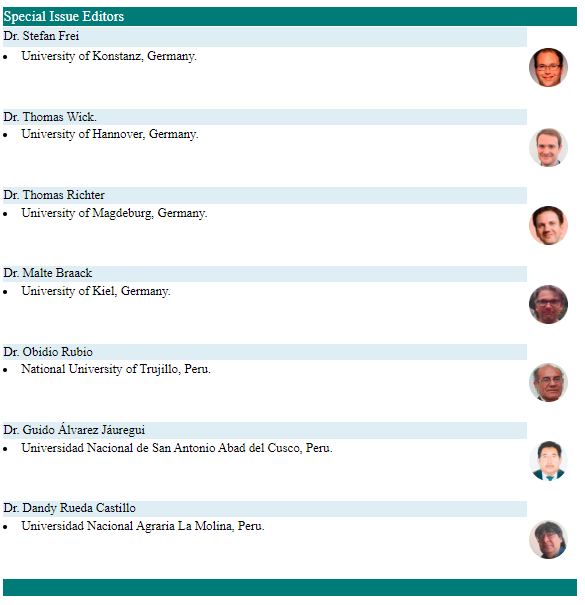Detecao de Bordas baseada em Morfologia Matemática Fuzzy Intervalar e as Funcoes de Agregacao K
DOI:
https://doi.org/10.17268/sel.mat.2019.02.10Palabras clave:
Deteccao de bordas, morfologia matemática fuzzy intervalar, morfologia gradienteResumen
A deteccao de bordas é uma ferramenta de processamento digital de imagenes. Ela determina pontos de uma imagem digital onde a intensidade da luz muda repentinamente. Esse processo aplica-se a uma imagem digital a qual supoe algum grau de incerteza na localizacao e na intensidade do pixel da imagem real. Neste trabalho, é proposto um modelo de detecao de bordas que consiste na captura dessa incerteza em termos de imagens intervalares, para depois aplicar a erosao e dilatacao intervalar fuzzy. Finalmente, por meio de uma combinacao convexa sobre os limites superiores e inferiores da erosao e a dilatacao intervalar, sao obtidas a erosao e a dilatacao morfológica respectivamente, com as quais se faz possível produzir uma imagem borda.
Citas
Baczynski, M., Beliakov, G., Humberto, H. and Pradera, A. Advances in Fuzzy Implication Functions. Springer, 2013.
Birkhoff, G. Lattice Theory. Providence: American Mathematical Society, 3rd, ed., 1993.
Bowyer, K. Kranenburg, C. and Dougherty,S. Edge detector evaluation using empirical ROC curves, Computer Vision and Image Understanding, 2001; 84(1):77–103.
Bustince, H., Fernández, J., Kolesárová, A. and Mesiar, R. Generation of linear orders for intervals by means of aggregation functions, Fuzzy Sets and Systems, 2013; 220:69-77.
Canny, J. F. A computational approach to edge-detection, IEEE Transactions on Pattern Analysis and Machine Intelligence, 1986; 8:679-700.
Davey, B. A. and Priestley, H. A. Introduction to lattices and Order. Cambridge University Press, 2002.
Deng, T. and Heijmans, H. J.Grey-scale morphology based on fuzzy logic, Journal of Mathematical Imaging and Vision, 2002; 16(2);155-171.
Deschrijver, G. and Cornelis, C. Representability in interval-valued fuzzy set theory, International Journal of Uncertainty, Fuzziness and Knowledge-Based Systems, 2007; 15(3):345-361.
Grätzer, G. A. Lattice Theory: First Concepts and Distributive Lattices. San Francisco, CA: W. H. Freeman, 1971.
Heijmans, H. J. Morphological image operators, Advances in Electronics and Electron Physics Suppl., Boston: Academic Press,| c1994.
González-Hidalgo, M., Massanet, S., Mir, A. and Ruiz-Aguilera, D. On the choice of the pair conjunction–implication into the fuzzy morphological edge detector, IEEE Transactions on Fuzzy Systems, 2015; 23(4):872-884.
González-Hidalgo, M. and Massanet, S. A fuzzy mathematical morphology based on discrete t-norms: fundamentals and applications to image processing, Soft Computing, 2014; 18(11):2297-2311
Grana, M., and Chyzhyk, D. Image understanding applications of lattice autoassociative memories, IEEE Transactions on Neural Networks and Learning Systems, 2015; 27(9):1920-1932.
Klir, G., and Yuan, B. Fuzzy sets and fuzzy logic, vol. 4. Prentice hall New Jersey, 1995.
Kovesi, P. D. Matlab and Octave functions for computer vision and image processing, Centre for Exploration Targeting, School of Earth and Environment, The University of Western Australia, available from: http://www.csse.uwa.edu. au/pk/research/matlabfns, 2000; 147:230.
Law, T., Itoh, H. and Seki„ H. Image filtering, edge detection, and edge tracing using fuzzy reasoning, IEEE transactions on pattern analysis and machine intelligence, 1996; 18(5):481-491.
Lopez-Molina, C., Marco-Detchart, C., Cerron, J., Bustince, H. and De Baets. Gradient extraction operators for discrete interval-valued data, in 16th IFSAWorld Congress; 9th Conference of the European Society for Fuzzy Logic and Technology, Atlantis Press, 2015; 89:836-843.
Medina-Carnicer, R., Munoz-Salinas, R., Yeguas-Bolivar, E. and Diaz-Mas, L. A novel method to look for the hysteresis thresholds for the Canny edge detector, Pattern Recognition, 2011; 44(6):1201-1211.
Nachtegael, M., Sussner, P., Mélange, T. and Kerre, E. On the role of complete lattices in mathematical morphology: From tool to uncertainty model, Information Sciences, 2011; 181(10):1971-1988.
Nachtegael, M. and Kerre, E. Connections between binary, gray-scale and fuzzy mathematical morphologies, Fuzzy sets and systems, 2001; 124(1):73–85.
Prewitt, J. Object enhancement and extraction, Picture Proc. Psychopictorics, 1970; 75-149.
Sussner, P. and Valle, M. Classification of fuzzy mathematical morphologies based on concepts of inclusion measure and duality, Journal of Mathematical Imaging and Vision, 2008; 32(2):139-159.
Sussner, Nachtegael, P., élange, M., Deschrijver, G., Esmi, E. and Kerre, E. Interval-valued and intuitionistic fuzzy mathematical morphologies as special cases of L-fuzzy mathematical morphology, Journal of Mathematical Imaging and Vision, 2012; 43(1):50-71.
Sobel, I. E. Camera models and machine perception, 1970.
Descargas
Publicado
Cómo citar
Número
Sección
Licencia
Los autores/as que publiquen en esta revista aceptan las siguientes condiciones:
- Los autores/as conservan los derechos de autor y ceden a la revista el derecho de la primera publicación, con el trabajo registrado con la licencia de atribución de Creative CommonsAtribución 4.0 Internacional (CC BY 4.0) , que permite a terceros utilizar lo publicado siempre que mencionen la autoría del trabajo y a la primera publicación en esta revista.
- Los autores/as pueden realizar otros acuerdos contractuales independientes y adicionales para la distribución no exclusiva de la versión del artículo publicado en esta revista (p. ej., incluirlo en un repositorio institucional o publicarlo en un libro) siempre que indiquen claramente que el trabajo se publicó por primera vez en esta revista.
- Se permite y recomienda a los autores/as a publicar su trabajo en Internet (por ejemplo en páginas institucionales o personales) antes y durante el proceso de revisión y publicación, ya que puede conducir a intercambios productivos y a una mayor y más rápida difusión del trabajo publicado(Consultar: efecto del acceso abierto).













